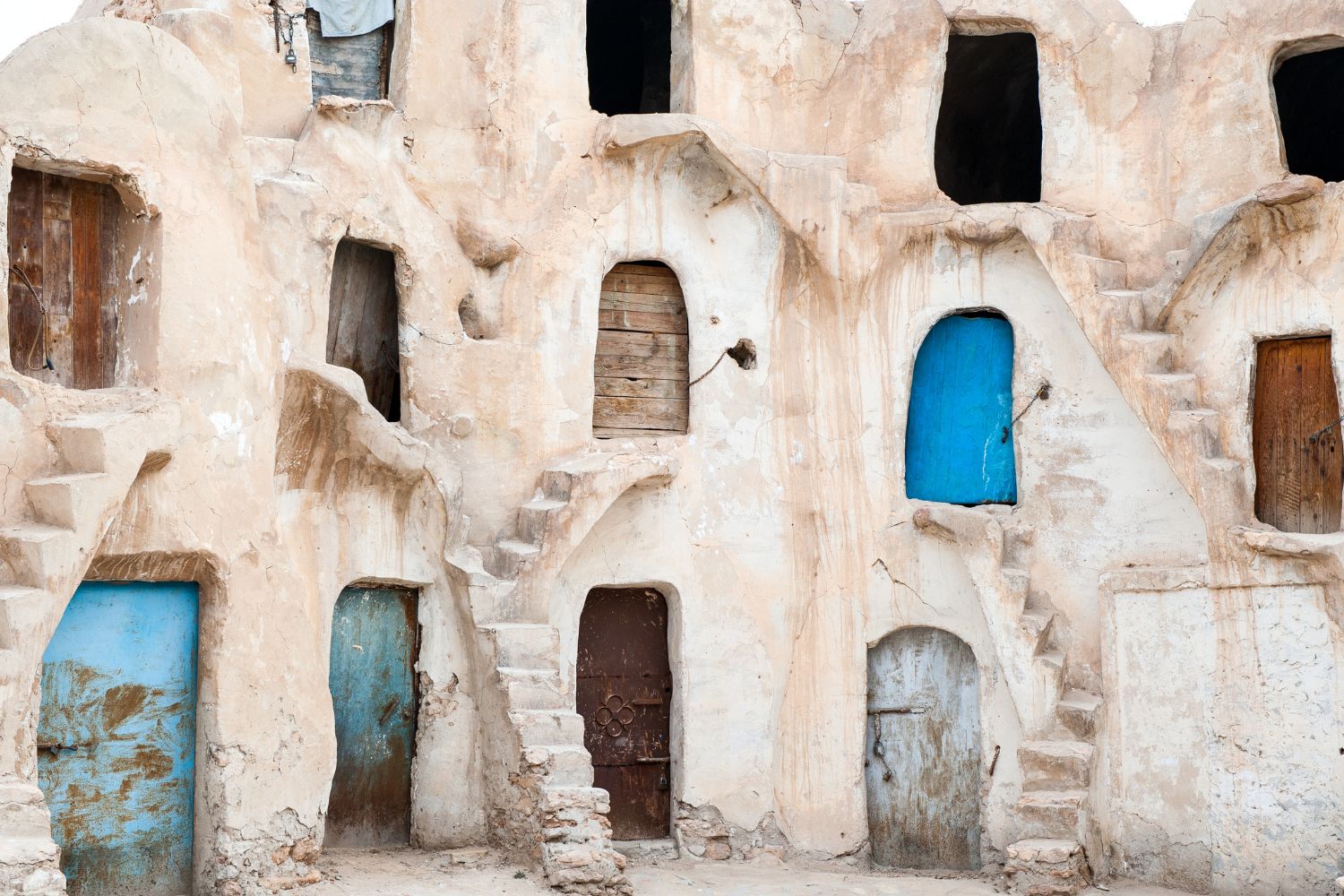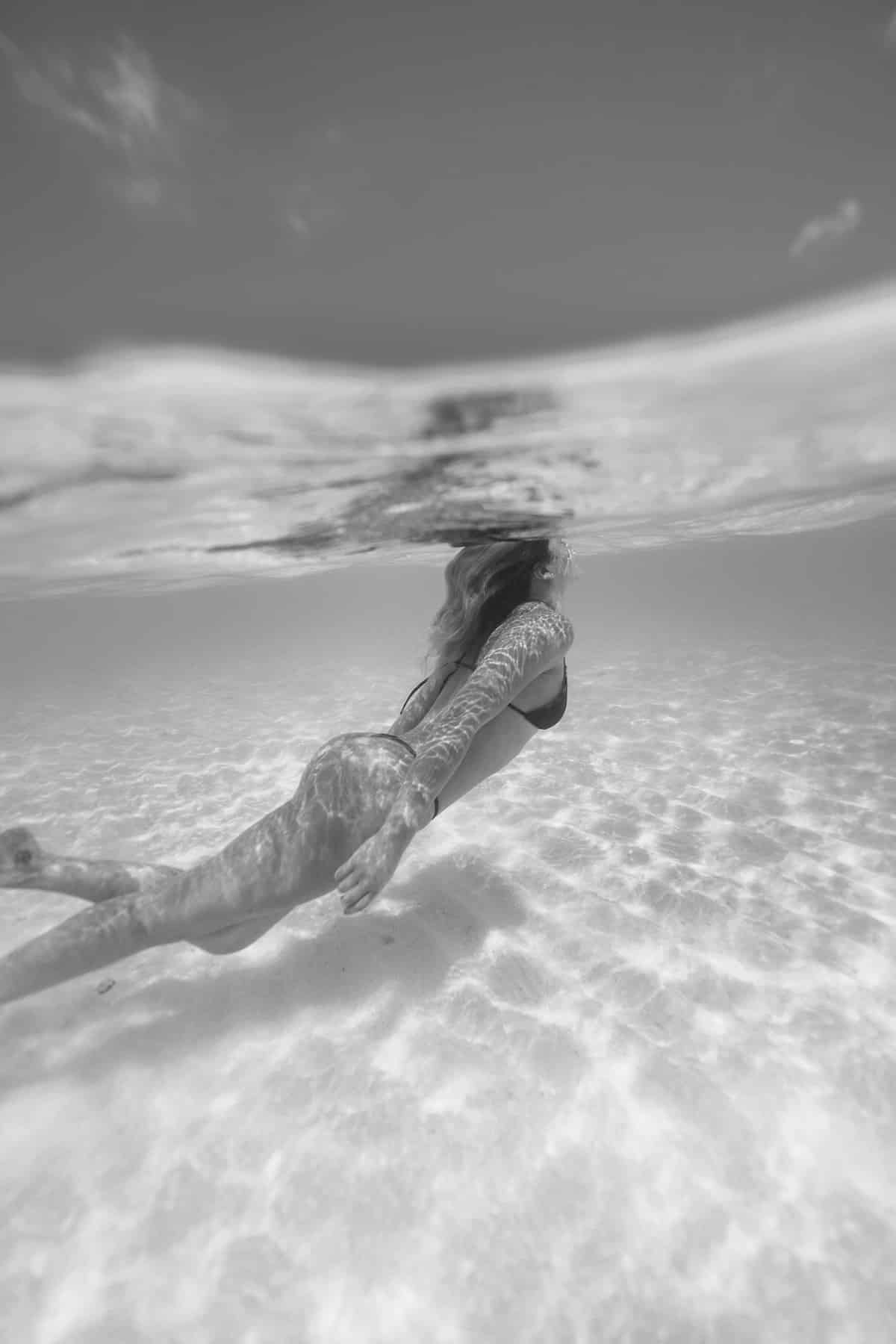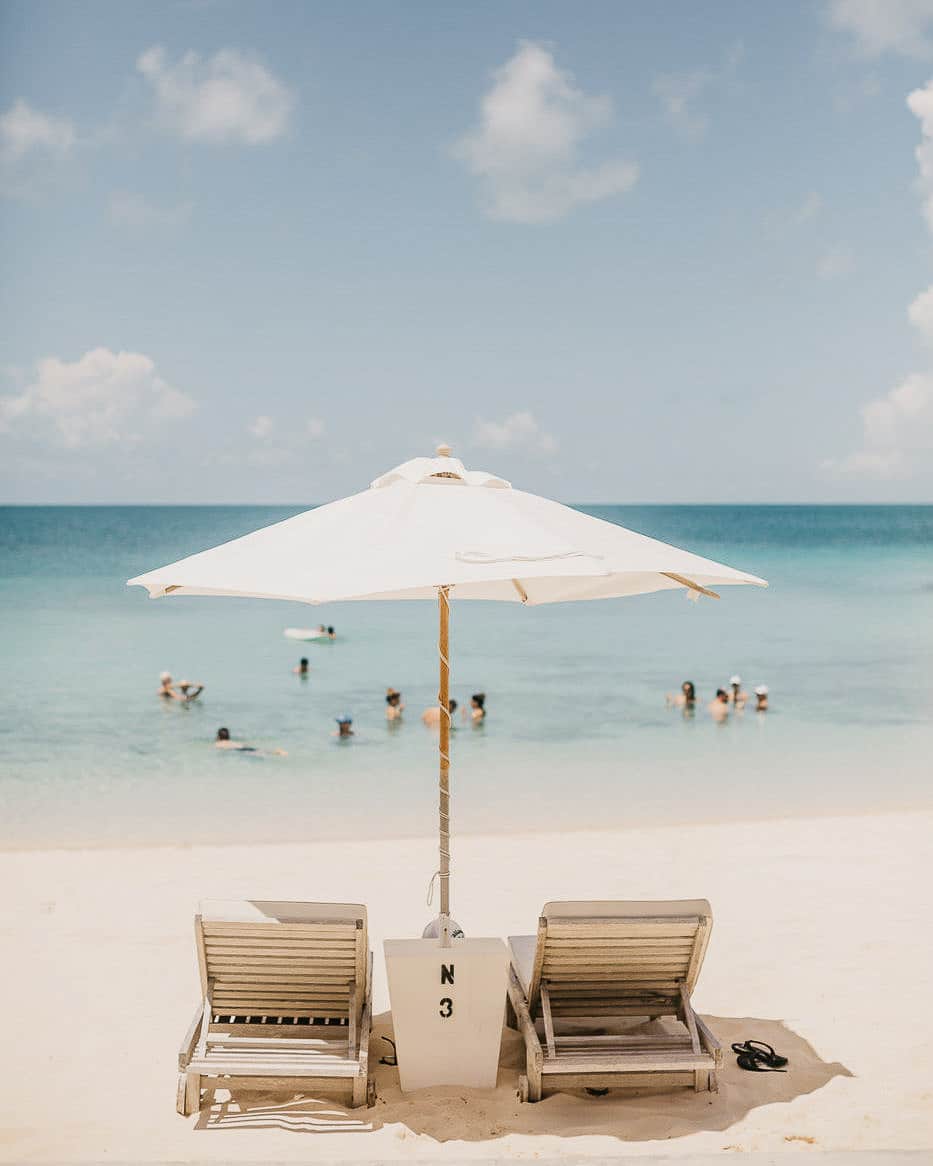Are you hiking to Olpererhütte, Austria, and its famous suspension bridge? Then, you’ve found the perfect guide to embark on this breathtaking adventure in the heart of the Zillertal Alps. This Olpererhütte hiking guide is designed to help you navigate the stunning landscapes of Olpererhütte, leading you to the famous suspension bridge that offers unparalleled views of the alpine surroundings.
We’ll discuss expert tips, route details, and must-see highlights, ensuring you experience what Olpererhütte offers, from the lush valley floors to the soaring peaks. Whether you’re an experienced hiker or just starting, get ready to be captivated by this remarkable Austrian hiking destination’s natural beauty and thrilling experience.
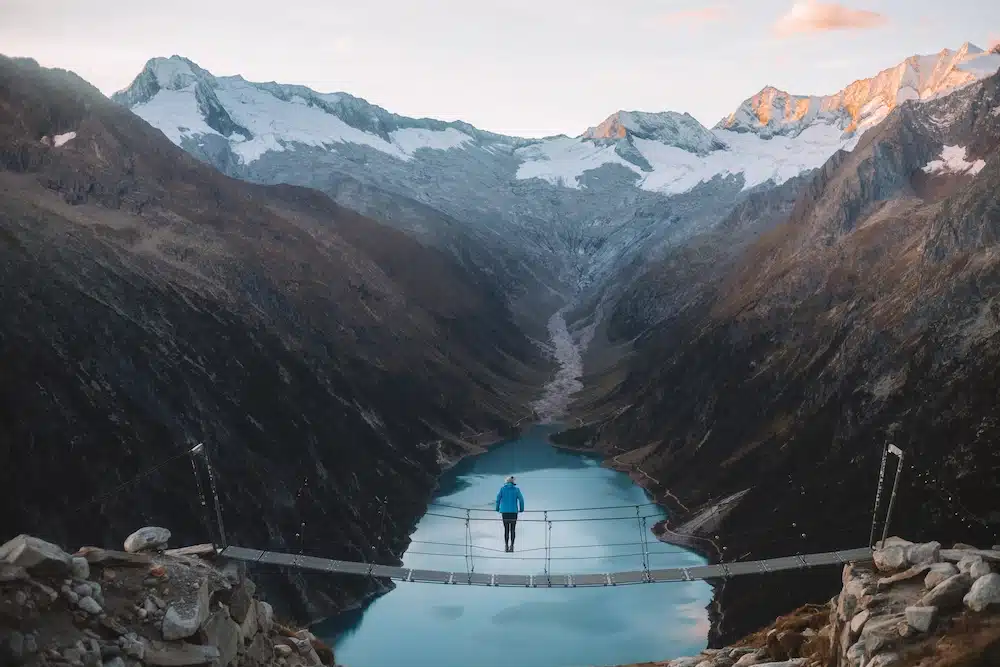
Why Olpererhütte and its Suspension Bridge are Must-Visit Destinations in Austria
Nestled amidst the majestic Zillertal Alps, Olpererhütte is not just any destination; it’s a journey into the heart of Austria’s natural splendor. As a passionate hiker and nature enthusiast, I have explored many trails. Still, the hike to Olpererhütte and its iconic suspension bridge stands out as a truly unforgettable experience.
Embarking on the Olpererhütte Hike in Austria’s Zillertal Alps
What makes this Olpererhütte hike unique is the final stop – a delightful alpine hut situated at an elevation of 2,389 meters, providing awe-inspiring views of the nearby mountain peaks. Additionally, the journey itself is remarkable. The trail winds through lush valleys, runs parallel to crystal-clear streams, and traverses over rough terrain, revealing a new panorama of nature’s splendor at each twist and turn.
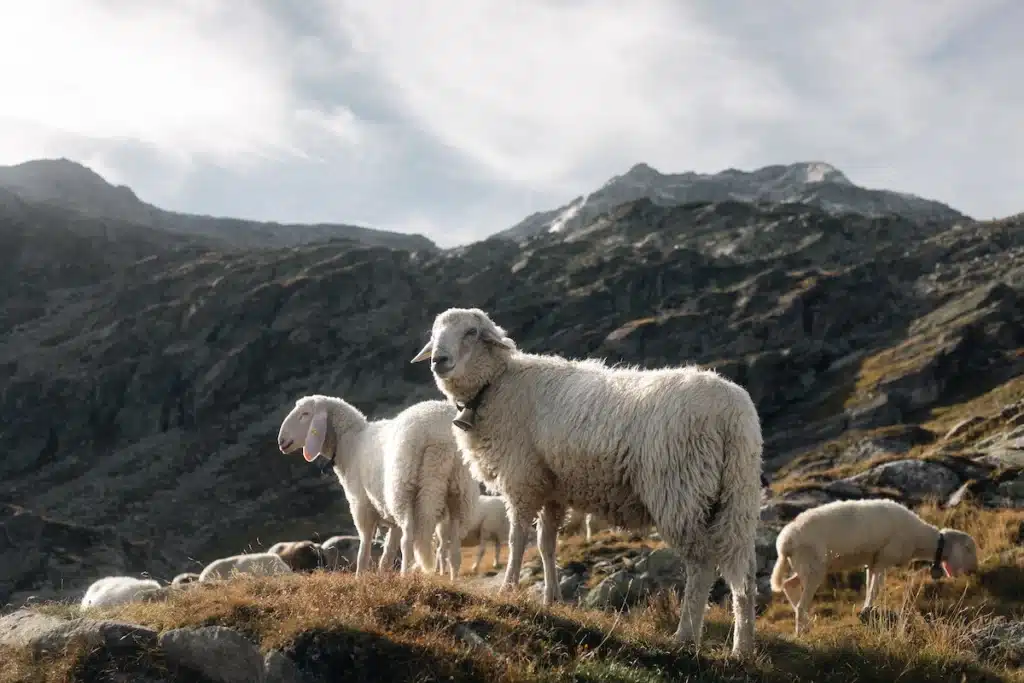
The Olpererhütte Suspension Bridge: A Highlight of the Austrian Alps
The suspension bridge near Olpererhütte is a true gem. It is suspended high above the ground and provides a breathtaking panoramic view that is both exhilarating and humbling. When I stood on that bridge and gazed out at the vast expanse of the Alps, I felt a deep sense of awe and connection with nature. The experience is all about the calmness of the mountains, the refreshing and cool alpine breeze, and the feeling of achievement when you finally reach the Olpererhütte hut.
Why the Olpererhütte Hike and Bridge Should Be on Your Austria Bucket List
Visiting Olpererhütte and crossing its famous suspension bridge is not just a hike; it is an experience that captures the essence of adventure and the magnificence of the Austrian Alps. Whether you are an experienced hiker or a casual wanderer, this journey guarantees to create unforgettable memories that will last a lifetime.
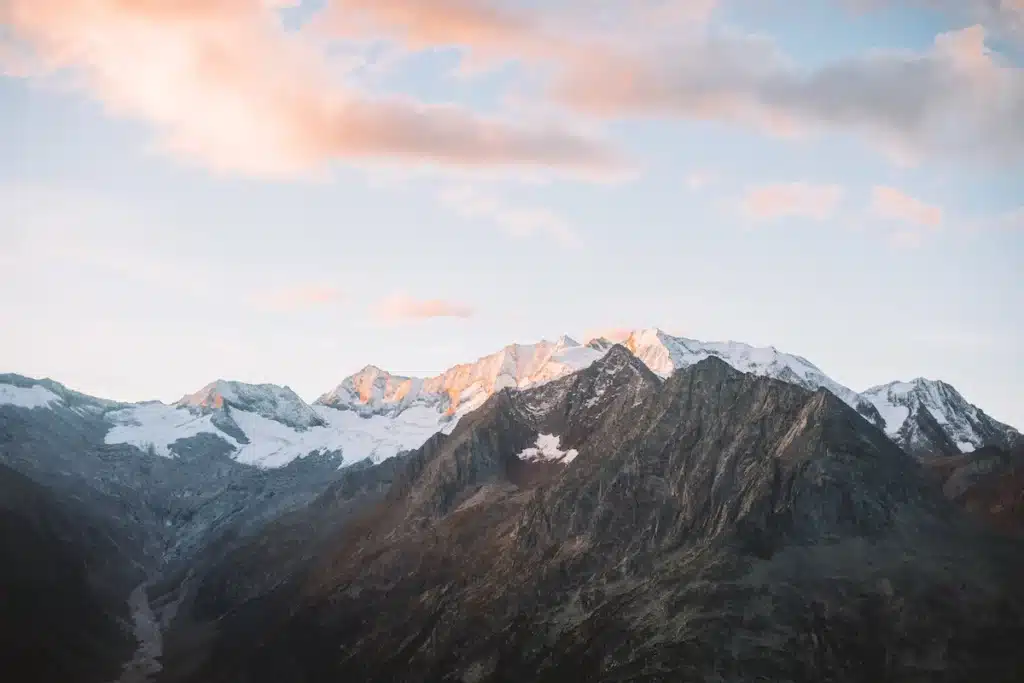
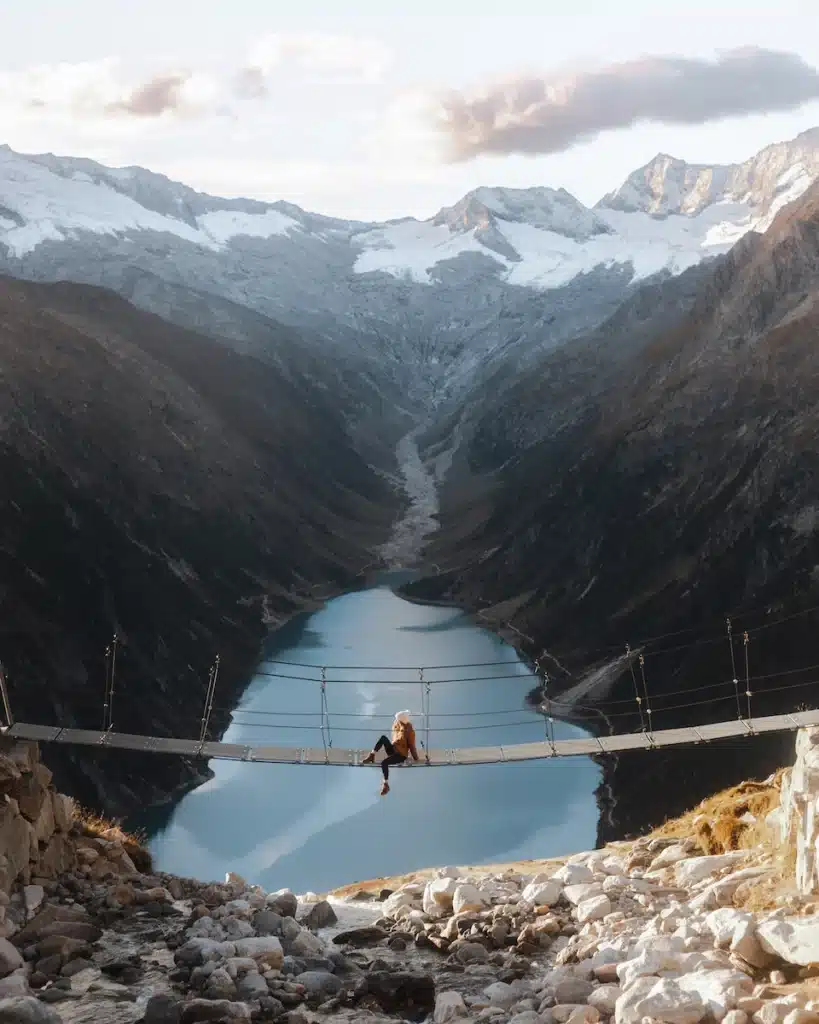
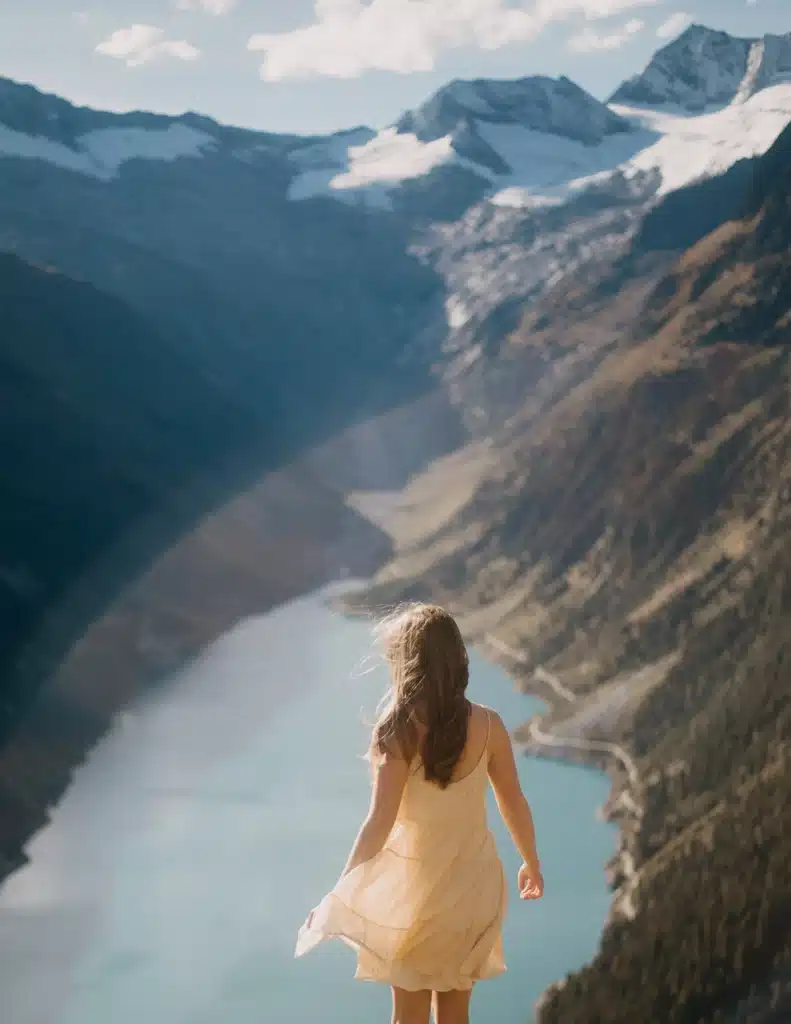
How do I get to Zillertal Alps?
The Zillertal Alps are a mountain range in Austria, extending also into Italy. To reach the Zillertal Alps, you’ll likely start your journey from Innsbruck, the capital city of Tyrol in western Austria, as it’s the nearest major city with a well-connected airport.
Here are the general steps to get to the Zillertal Alps:
Fly into Innsbruck:
If you’re coming from international destinations or other parts of Austria, flying into Innsbruck Airport (INN) would be the most convenient. From there, you can rent a car or use public transport to get to the Zillertal valley.
CHECK HERE | Flights to and from Innsbruck, Austria
By Car:
Renting a car would give you the flexibility to explore the Zillertal Alps at your own pace. From Innsbruck, you would take the A12 motorway towards Zillertal. The drive usually takes about an hour, depending on your specific destination within the Alps.
CHECK HERE | Car Rental in Innsbruck, Austria
By Train:
The Austrian Federal Railways (ÖBB) operates regular train services from Innsbruck to Jenbach. From Jenbach, you can transfer to the Zillertalbahn, a local train service that runs through the Zillertal valley to Mayrhofen, which is one of the main hubs for accessing different parts of the Zillertal Alps.
CHECK HERE | Train Schedule from Innsbruck, Austria
By Bus:
From Innsbruck or Jenbach, you can also take a bus that will take you into the Zillertal valley. Buses can be a more economical option, and they serve many of the smaller villages that might not be directly accessible by train.
CHECK HERE | Bus Schedule from Innsbruck, Austria
Outdoor Adventure Companies: There are also outdoor adventure companies that offer guided tours and transport services specifically for hikers, climbers, and skiers heading to the Zillertal Alps.
CHECK HERE | Private Full-Day Tour of Dolomites, Alpine Lakes including Braies from Innsbruck
Essential Facts About the Olpererhütte Hike
- Ideal Timing: End of September for perfect weather conditions and fewer crowds.
- Unique Experience: Overnight stay at Olpererhütte, with a pre-dawn hike to witness a spectacular sunrise.
- Photography Tips: Sunrise offers a magical orange hue on the mountains, and the low light pollution allows for stunning star photography at night.
- Lighting Considerations: Midday provides the best lighting for the lake, but softer light in the early morning or late afternoon creates dramatic effects with mountain shadows.
- Crowd Avoidance: Shoulder seasons offer fewer crowds. Staying overnight at Olpererhütte allows for exclusive access to the bridge during sunrise and sunset.
- Hidden Gems: Venturing just 100 meters past the bridge leads to quieter spots with amazing views of Schlegeis lake – often overlooked by many hikers.
What Makes the Olpererhütte Hike Special?
- Scenic Diversity: The trail’s variety from lush valleys to rugged terrain offers a rich visual journey.
- The Suspension Bridge: A marvel of engineering offering breathtaking views, especially enchanting at sunrise and sunset.
- Starry Nights: The low light pollution in the area provides an incredible opportunity for star gazing.
- Cultural Depth: Olpererhütte’s rich history adds a layer of cultural significance to the hike.
- Photogenic Landscapes: Ideal for photographers seeking the perfect blend of natural beauty and dramatic lighting.
Olpererhütte Hike in a Nutshell
- Location: Zillertal Alps, Austria
- Starting Point: Schlegeisspeicher Reservoir (Schlegeis Stausee)
- End Point: Olpererhütte and its Suspension Bridge
- Distance: Approximately 13.8 km round trip
- Elevation Gain: 880 meters
- Difficulty: Moderate to challenging
- Estimated Duration: 5 hours round trip
- Best Time to Visit: Early Fall, early spring
How do I get to Schlegeis Stausee – The Olpererhütte Trailhead?
Directions by Bus
To reach the trailhead by bus, take bus number 4102 from the Mayrhofen Bahnhof Train/Bus Station to Schlegeisspeicher reservoir. 16 buses depart each day, starting at 7:35 am. The journey takes about 50 minutes, and the last bus leaves Schlegeisspeicher Reservoir at 6:10 pm. A one-way ticket costs 10 EUR per person, which includes the ride and a toll fee.
Directions by Car
If driving, head from Mayrhofen towards Ginzling and follow the 13.3 km Alpenstrasse Schlegeis road to the Schlegeisspeicher reservoir. This alpine road is typically open from late May until late October. The toll fee for cars is 15.50 EUR (11.50 EUR for motorbikes), payable in cash near the toll station at Gasthof Breitlahner. There’s no additional fee for parking.
Tips for Navigation and Parking
- Early Start: Whether taking a bus or driving, starting early is advisable to avoid crowds and enjoy a more peaceful hike.
- Carry Cash: Remember to carry cash for the toll fees, as they are payable in cash only.
- Parking Tips: Arrive early to find parking, especially during peak seasons. Bus travelers should know the last bus departure to avoid being stranded.
- Trail Signage: Follow the yellow hiking signs and trail numbers for navigation.
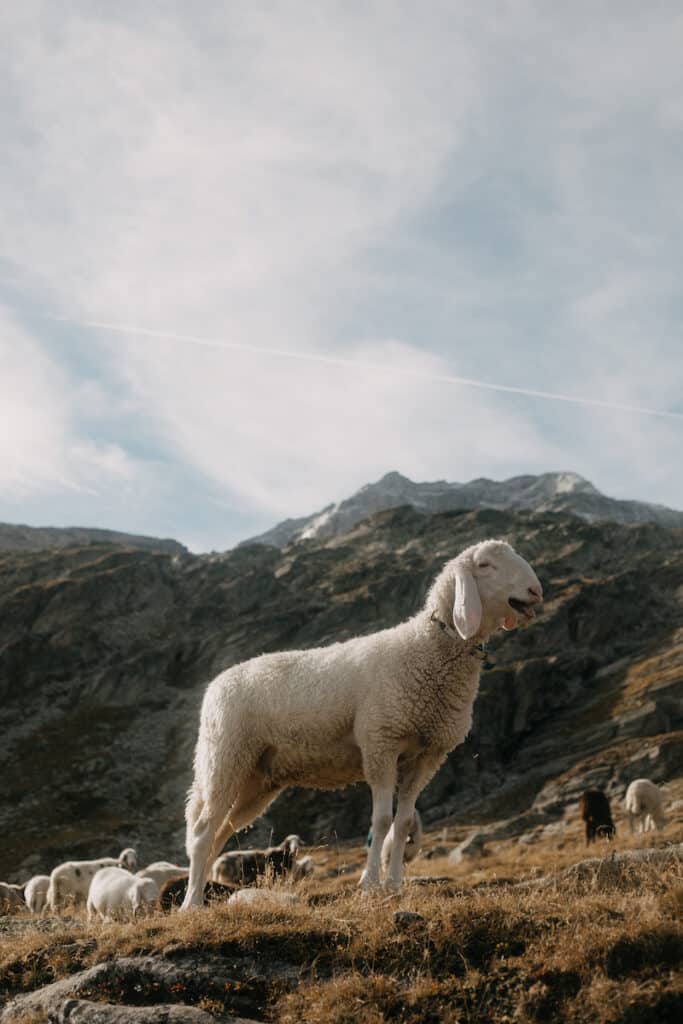
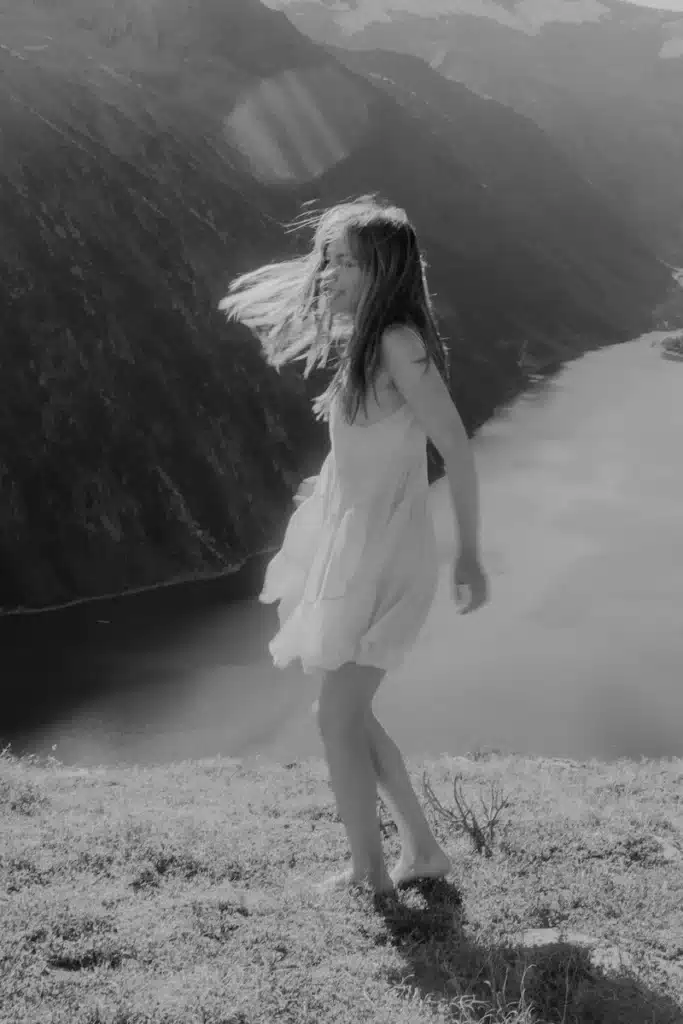
Best Time to Hike to Olpererhütte
When planning the Olpererhütte Hike, it’s essential to consider the seasons and choose the best months. The alpine environment can be challenging, so taking precautions and being prepared is vital.
Seasonal Considerations and Weather Tips
- Weather Variability: Mountain weather can be unpredictable. Even in summer, the weather at higher elevations, like Olpererhütte, can change rapidly. Be prepared for sudden temperature drops and rain.
- Snow Cover: Depending on the season, snow can be a factor. Late spring and early fall may still have snow patches, affecting trail accessibility and safety.
- Daylight Hours: Consider the length of daylight when planning your hike. Longer days in summer provide more time for hiking and enjoying the views.
- Crowds: Summer, especially July and August, tends to be more crowded. If you prefer a quieter experience, consider your hike to Olpererhütte during shoulder seasons.
- Preparation: Regardless of the season, it’s crucial to be well-prepared with appropriate gear, including sturdy hiking boots, warm clothing, rain gear, and sufficient water and food.
Ideal Months for the Olpererhütte Hike
- Late Spring to Early Fall: Generally, the best time to hike to Olpererhütte is from late spring (late May) to early fall (mid-October). This period typically offers the most favorable weather conditions.
- Summer Months: June to September are popular due to warmer temperatures and more apparent trails. However, this is also when the trail is busiest.
- Shoulder Seasons: Late May, September, and early October are ideal if you’re looking to avoid crowds. The weather can be more unpredictable, but the trails are less crowded, and the landscape is often at its most beautiful.
- Personal Experience: Based on my visit in late September, I found the weather perfect – not too hot during the day and pleasantly cool in the evenings. The fewer visitors during this time also made the experience more serene and enjoyable.
It’s always a good idea to check the weather forecast and trail conditions before setting out on your Olpererhütte hike since weather conditions vary yearly. You can verify on this website this website.

Step-by-Step Hike Description: From Start to Olpererhütte Suspension Bridge
Schlegeisspeicher Reservoir to Friesenberghaus
- Starting Point: Begin your hike at the Schlegeisspeicher Reservoir, an impressive structure nestled in the Zillertal Alps.
- Trail Details: The path starts off relatively gentle, winding through alpine meadows and offering stunning views of the reservoir.
- Highlights: As you ascend, the scenery shifts, with the sound of trickling streams and the sight of lush greenery around.
- Duration: This section of the hike takes approximately 2 hours, during which you’ll gain a significant amount of elevation and start to feel the isolation of the high mountains.
Friesenberghaus to Olpererhütte
- Changing Landscape: Leaving Friesenberghaus, the trail becomes more rugged. Expect rocky terrain and a steeper ascent.
- Scenic Views: The path offers expansive views of the valley below and the surrounding peaks. Keep an eye out for local wildlife in this area.
- Approaching Olpererhütte: As you near Olpererhütte, the anticipation builds with each step, culminating in the arrival at this iconic mountain refuge.
- Duration: This stretch typically takes about 1.5 to 2 hours, depending on pace and conditions.
Olpererhütte to the Suspension Bridge
- The Final Stretch: The last section to the suspension bridge is relatively short but rewarding.
- Suspension Bridge: Reaching the suspension bridge is a highlight of the hike. It’s a popular spot for photos due to its dramatic setting and stunning backdrop.
- Experience: Walking across the bridge, you’ll feel a thrilling sense of achievement, with panoramic views of the Alps surrounding you.
- Duration: This part of the hike is brief, usually taking around 15 to 30 minutes.
Return Journey: Olpererhütte to Schlegeisspeicher Reservoir
- Descent: The return journey involves retracing your steps back to the Schlegeisspeicher Reservoir.
- Pace: Descents can be quicker but require caution, especially on steep or rocky sections.
- Reflection: Use this time to reflect on the incredible experience and the beauty you’ve witnessed.
- Duration: The descent generally takes less time than the ascent, but it’s important to pace yourself and take breaks as needed.
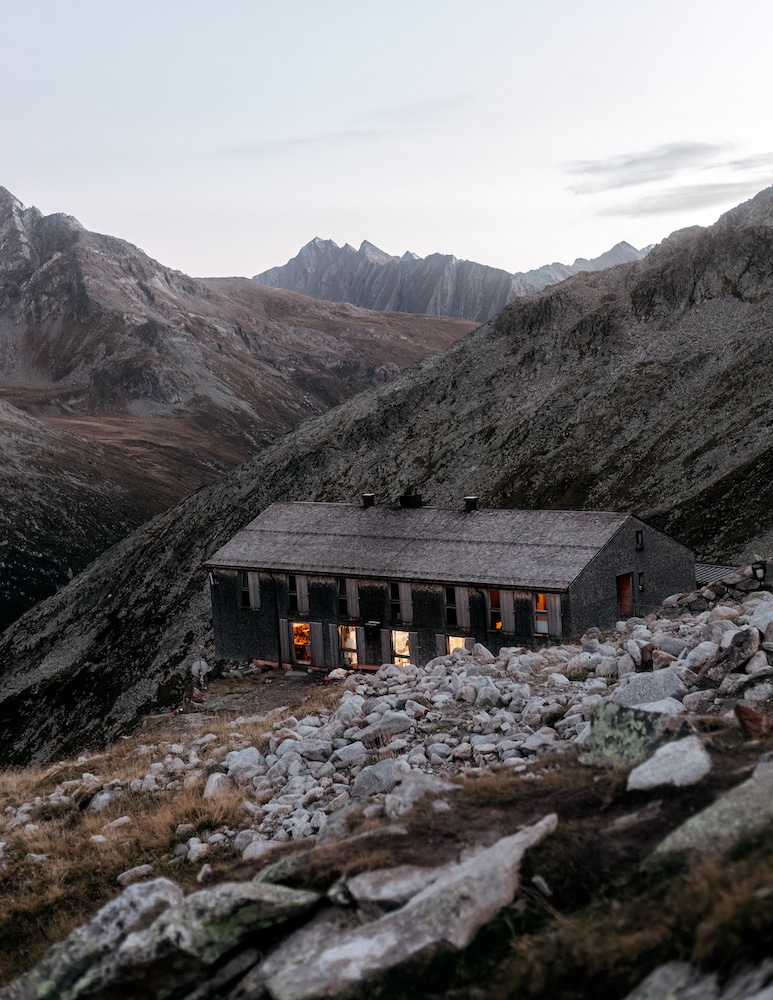
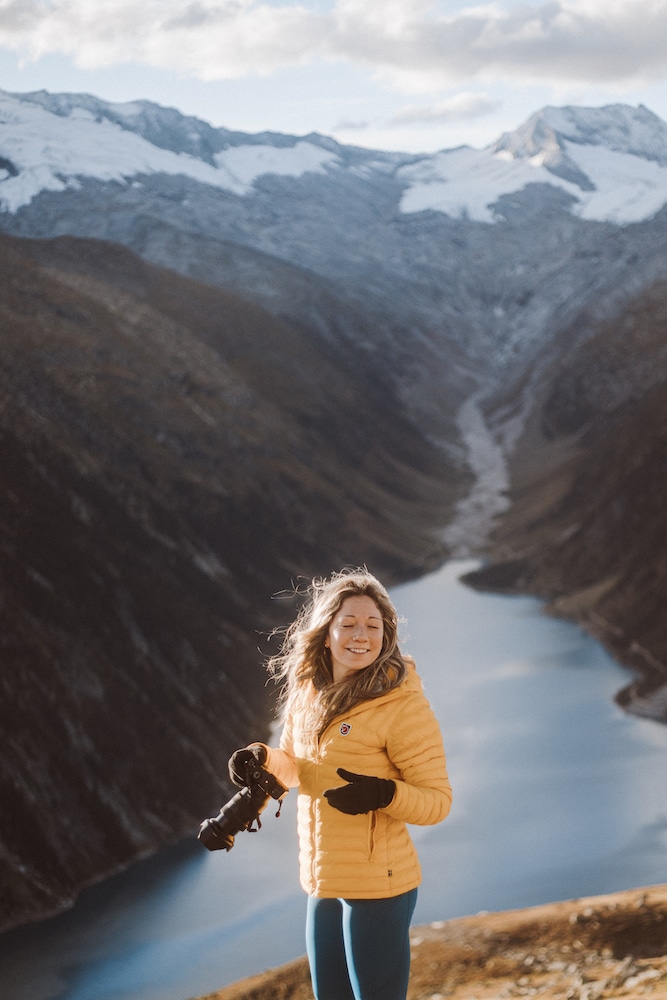
Accommodation Options: Staying Overnight at Olpererhütte
Staying at Olperer Mountain Hut provides a unique opportunity to immerse yourself in nature.
The Olperer Mountain Hut Experience
- Atmosphere: There’s an indescribable magic in spending a night at a mountain hut, especially one like Olpererhütte. Surrounded by the raw beauty of the Ziller Valley, the hut provides a sense of closeness to the natural world that’s both humbling and exhilarating.
- Journey to the Hut: The trip to the hut is an adventure. The approach sets the stage for the remarkable experience that awaits at the hut.
- Stunning Views: Once at the Olperer Mountain Hut, you are greeted with panoramic views of the majestic mountains and the serene valleys below. Clear nights offer a spectacular star-gazing opportunity, adding to the unforgettable experience.
Booking and Facilities at Olpererhütte
- Availability: The hut is open from late May to early October. It’s wise to book well in advance, especially during peak seasons.
- Amenities: While it’s not a luxury hotel, the family-run Olpererhütte offers essential amenities. Expect a cozy restaurant, bar, and a small shop for basic necessities.
- Accommodation Style: The hut provides dormitory-style sleeping arrangements. It’s a great way to meet fellow hikers and share stories.
- Pricing: Prices start at about €25 per night, offering an affordable and authentic alpine experience.
Alternative Accommodations Nearby Olpererhutte in the Zillertal Alps
The Zillertal area has plenty to offer for those looking for different types of accommodations. From budget-friendly guesthouses to more upscale hotels, there’s something for every preference and budget.
Many alternative accommodations are conveniently located near the trailhead or towns like Mayrhofen, making them an excellent base for your hike. To ensure availability, research and book accommodations in advance, especially during the high season. Here are a couple of hotel options:
Nennerhof: Nestled in the heart of Tux, Nennerhof is a charming self-catering accommodation that combines convenience with modern Alpine living. Renovated in 2018 and boasting ski-to-door access, it’s a mere 500 meters from the year-round Hintertux Glacier cable car. Each apartment offers the comfort of 2 or 3 TVs, a balcony to admire the mountainous horizon, and a cozy seating area perfect for unwinding after a day on the slopes or a hike.
CHECK AVAILABILITY | Nennerhof
Der Rindererhof: Located at 1,500 meters above sea level in the Tux Valley, the Rindererhof is right next to the cable car into the Hintertux Glacier all-year ski area. It offers a spa area and free Wi-Fi. The spacious and elegantly furnished rooms feature satellite TV, a safe, and a bathroom with a hairdryer and bathrobes. Most have a balcony.
CHECK AVAILABILITY | Der Rindererhof
Austria Travel Essentials for Hikers
Best Times to Visit Austria for Hiking
The ideal hiking season in Austria stretches from late June to early September, when the Alpine meadows bloom and mountain paths are clear of snow. For autumn foliage, September to October is splendid, though higher trails may be less accessible.
Navigating Austria: Transportation Tips
Austria’s public transportation is efficient and comprehensive. Trains and buses service most trailheads, and the ÖBB (Austrian Federal Railways) offers convenient options for reaching remote areas. Consider the ‘Österreichische Wander- und Bergsteiger- abo’ for unlimited travel on weekends.
Car Rental Information
For those seeking flexibility, car rentals are available at airports and city centers. Remember that a ‘Vignette’ toll sticker is mandatory on highways, and parking at trailheads can sometimes be limited.
CHECK HERE | Car Rental in Innsbruck, Austria
Popular Trails and Regions
The Eagle Walk in Tirol and the Salzburger Almenweg are among Austria’s most iconic trails. The Dachstein circuit offers breathtaking glacial views, while the Zillertal Alps are perfect for experienced hikers seeking a challenge.
Hut-to-Hut Hiking Options in Austria
Austria’s vast network of mountain huts allows for multi-day hikes from hut to hut. The Austrian Alpine Club and private hut operators provide comfortable accommodations, but you can book in advance, especially during peak season.
Essential Gear and Preparation Tips
Proper gear is crucial for Austrian hiking adventures. Invest in quality hiking boots, weather-appropriate clothing, a reliable map or GPS device, and a lightweight backpack. Always check weather forecasts and trail conditions before departure, and consider altitude adjustments for high mountain treks.
The Olpererhütte Austria & Suspension Bridge: Final Thoughts
As you leave the Olpererhütte bridge behind, it’s with the knowledge that you’ve traversed more than just a physical structure; you’ve experienced a place where the human world and nature’s splendor exist in perfect harmony. It’s an encounter that’s sure to resonate within you, long after your footsteps have echoed off the bridge’s planks, a reminder of the raw and rugged beauty of the Austrian Alps.
The bridge is more than a connection between two points; it is a journey between the grandeur of nature and the spirit of adventure within each of us. As one of the most photogenic bridges globally, it’s a paradise for photographers and nature enthusiasts. Here, you might glimpse the elusive Alpine ibex, a treasure to behold in Olpererhütte Austria.
FAQ’s about Olpererhütte Austria
During winter, Austria usually experiences chilly weather, with January being the coldest month of the year. The temperatures generally vary from -4 degrees Celsius to 4 degrees Celsius. However, in cities, the average temperature is usually around 1 degree Celsius, while higher altitudes and mountain regions can see temperatures drop to about -3.5 degrees Celsius or lower.
The elevation gain to reach the Olpererhütte, a popular hiking destination in the Zillertal Alps of Austria, is approximately 600 meters or 1,969 feet. This makes it a moderately challenging hike, offering stunning views and a rewarding experience for those who undertake the ascent.
The hike to Olpererhütte varies in length depending on the starting point. If you begin the hike from the Schlegeisspeicher (Schlegeis reservoir), it is typically around 6 kilometers (about 3.7 miles) one way. The average time for this hike is about 2 to 3 hours, depending on your pace and how often you stop to enjoy the scenery. It’s considered a moderately challenging hike due to the elevation gain and the high alpine environment.
Do you like adventuring?
Astrophotography for Beginners: How to Photograph the Moon?
7 Most Beautiful Lakes in the Dolomites
Choosing the Best Lens for Travel Photography
The 20 Best Things to Do in Ericeira Portugal
Discover Warredal: A Unique Treehouse Resort Experience in Belgium
